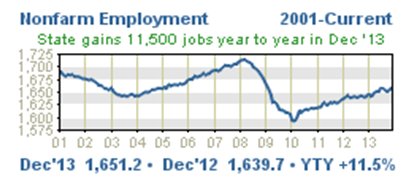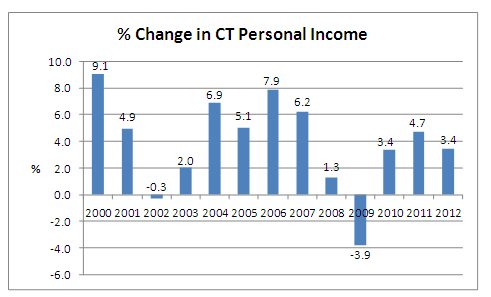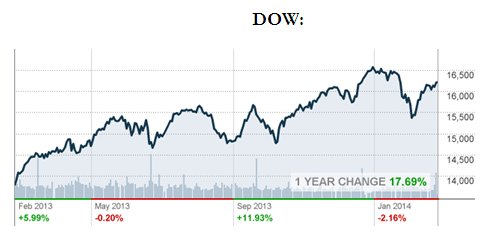Comptroller Kevin Lembo Archive > News
Comptroller Lembo Projects $504.4 Million Surplus for Fiscal Year 2014Comptroller Kevin Lembo today announced that the state is
currently on track to end Fiscal Year 2014 with a $504.4 million surplus.
In a letter to Gov. Dannel P. Malloy, Lembo said he agrees with the Office of
Policy and Management's (OPM) most recent projection, which is a slight decrease
of $1.7 million from last month's report due to various adjustments to spending
projections.
The largest increase in estimated spending is within the judicial branch - however, spending projections remain more than $50 million below initial budget targets.
Revenue, on the other hand, continues to exceed initial budget targets by $421.2 million, Lembo said. The three largest tax categories - income, sales and corporations - are all exceeding initial budget expectations, with the largest in the income tax at $213.1 million. The stock market has continued to post double-digit gains that have fueled the estimated income tax payments, Lembo said.
"As you know, I have advocated for the deposit of General
Fund surplus dollars to the state's Budget Reserve Fund in accordance with
current law," Lembo said in his letter to Malloy. "I have advocated for a
reserve level of 15 percent of spending, which is also endorsed within your
surplus distribution plan. Sufficient dollars in reserve will guard against
future tax increases and service reductions during inevitable future
recessionary cycles.
"As the disposition of the surplus is debated, policy makers should remember
that the Fiscal Year 2014 General Fund budget relies on $190.8 million in
nonrecurring revenue reserved from the prior year and $112.4 million in carry
forward funding. In addition, the majority of
the surplus dollars in Fiscal Year 2014 result from a one-time amnesty program,
and from the most volatile component of the income tax, which relies on strong
stock market performance.
"Finally, both OFA (Office of Fiscal Analysis) and OPM have estimated budget shortfalls beginning in Fiscal Year 2016 if current policies remain unchanged. I recommend that any General Fund surplus realized by the close of Fiscal Year 2014 in excess of this month's estimate be deposited directly to the Budget Reserve Fund."
Lembo said updated employment data will not be available
until March 14, but he pointed to several economic indicators worth considering
that relate to both the national and state economies -- particularly concerning
college graduates and the rate of first-time homebuyers.
"The housing market in Connecticut is an economic bright spot," Lembo said,
noting that the state's real estate conveyance tax receipts are running 71
percent above the same period last fiscal year. "This resurgence, however, is
leaving first-time homebuyers - young adults in their 30s - behind."
Nationally, first-time homebuyers accounted for 26 percent of purchases in
January, down from 27 percent in December, according to the National Association
of Realtors. Historically, first time homebuyers have accounted for about 40
percent of home sales (50 percent at their peak in 2009).
The Mortgage Bankers Association has noted that ballooning levels of student
debt, which have tripled to more than $1 trillion over the last decade, have had
a dampening effect on the ability of young people to save for homes.
The Federal Reserve found that from 2009 to 2012, the homeownership rate fell twice as much for 30-year-olds who had a history of student loans than it did for those without such debt.
"This crisis of crippling student debt imposes significant consequences - not only on an entire generation of struggling young adults - but on all aspects of the Connecticut and national economies," Lembo said. "These realities - ballooning student debt and deflating first-time homeownership - challenge our traditional belief that a college education presents opportunities to develop wealth and assets. This troubling trend breeds other economic challenges, and deserves our attention."
David H. Stevens, chief executive of the Mortgage Bankers Association, was recently quoted in The Washington Post: "This is a huge issue for us," Stevens said in The Washington Post.
"Student debt trumps all other consumer debt. It's going to have an extraordinary dampening effect on young peoples' ability to borrow for a home, and that's going to impact the housing market and the economy at large."
In terms of other relevant economic indicators, Lembo highlighted data and other information from federal and state Departments of Labor and other sources that show:

-
Year-to-date gains in the employment-driven withholding portion of the state income tax have been eroding since October. Total income tax withholding collections through January were up just 0.8 percent over the same period last year. In Fiscal Year 2013, the withholding portion of the income tax declined. These numbers are indicative of the state's challenging job market.
-
State employment data for January will not be released until March 14. According to Department of Labor data, the state lost 3,900 jobs in December. This more than eliminated the 3,800 jobs gained in November.
-
In 2013, the state posted eight months of job gains and four months of job losses. Nationally, job gains occurred in every month of 2013. The national rate of job growth in 2013 was more than double Connecticut's rate of growth.
-
For the 12-month period ending in December, Connecticut added 11,500 payroll positions. Job growth in 2013 averaged 958 positions per month; in 2012, job additions averaged 717 positions per month. Through the end of 2013, Connecticut had recovered 59,400 positions, or 49 percent of the 121,200 seasonally adjusted total nonfarm jobs that were lost in the March 2008 - February 2010 employment recession. Listed below is a table provided by the Department of Labor showing sector gains and losses for 2013.
Connecticut's Ten Industry Supersector Performance (YTD December 2013: 5 up, 5 down, before revisions)
| 1.) Education and Health Services (7,900, 2.5%) | 6.) Information (-600, -1.9%) |
| 2.) Construction and Mining (5,800, 11.4%, combined) | 7.) Government (-1,300, -0.5%) |
| 3.) Trade, Transportation, and Utilities (4,200, 1.4%) | 8.) Financial Activities (-1,300, -1.0%) |
| 4.) Professional and Business Services (1,400, 0.7%) | 9.) Other Services (-1,400, -2.2%) |
| 5.) Leisure and Hospitality (800, 0.6%) | 10.) Manufacturing (-4,000, -2.5%) |
-
Nationally employment numbers were disappointing in both December and January with the addition of 75,000 and 113,000 jobs in the respective months. This followed strong employment growth in October and November. November was notable with
a gain of 274,000 payroll jobs. -
Connecticut's unemployment rate in December stood at 7.4 percent. This compares to a national rate of 6.6 percent.

![]()
-
Personal income in Connecticut grew at a rate of 0.8 percent between the second and third quarters of 2013. This ranked Connecticut 37th nationally in income growth. On a full year basis, growth was 3.5 percent. For calendar year 2012, Connecticut personal income advanced at a 3.4 percent rate. Data for the fourth quarter will be released on March 25.
-
The chart below shows the annual trend in Connecticut personal income, updated by the Bureau of Economic Analysis on September 30, 2013. Because the state spending cap is based on the growth in personal income (or inflation if higher), the current trend places downward pressure on budgeted state spending. The cap does not apply to debt-financed spending.

-
Average hourly earnings at $28.00, not seasonally adjusted, were down 31 cents, or -1.1 percent from the December 2012 hourly private sector pay estimate. The resulting average private sector weekly pay was calculated at $940.80, down $27.40, or -2.8 percent over the year.
-
The year-to-year change in the Consumer Price Index for All Urban Consumers (CPI-U, U.S. City Average) in December 2013 was 1.5 percent.

-
A strong housing market has lifted Connecticut's real estate conveyance tax receipts. Through January, total receipts are running 71 percent above the same period last fiscal year.
-
According to a report from Berkshire Hathaway Home Services, there were 28,058 single family home sales in Connecticut in 2013, 12.3 percent higher than the number of sales in 2012 and totaling $11.4 billion in sales volume, one of the best years since 2006. At the same time, condominium closings totaled 7,174 up 19.8 percent. Growth in home sales was strongest in Fairfield, Litchfield, Hartford, Windham and New London Counties.
-
Median price increased 2.8 percent to $255,000 for single family properties and up 3.4 percent to $167,000 for condominiums. New Haven County median prices grew the most with a 4.3 percent change in single families and Litchfield grew 17 percent
in condominiums. -
Connecticut's foreclosure activity rate stands at 3.5 percent, the percentage of all mortgaged homes in some sort of legal action, according to data collecting company CoreLogic. This ranks the State in 5th place in the United States, tied with the State of Maine, for highest percentage of foreclosure inventory as a percent of all mortgaged homes. Lowering foreclosure inventories will help the real estate market improve.
-
Nationally, existing home sales fell 5.1 percent in January from a year ago-- their lowest level in 18 months. Home prices remained strong up 10.7 percent due to a low inventory of homes for sale. Weather played a significant role in slowing sales growth in January.
-
As discussed earlier above, first-time buyers accounted for 26 percent of purchases in January, down from 27 percent in December. Historically, first-time home buyers have accounted for about 40 percent of home sales. That number peaked at just over 50 percent in 2009.
-
Regionally, existing-home sales in the Northeast declined 3.1 percent to an annual rate of 620,000 in January, and are also 3.1 percent below January 2013. The median price in the Northeast was $241,100, up 6.6 percent from a year ago.
![]()
-
The estimated payment portion of the income tax grew by almost 25% through January of last fiscal year. This large increase was partially attributable to a capital gains tax change, effective at the end of 2012, and resulted in a roll-forward of taxable gains to Fiscal Year 2013. Absent the tax change, these roll-forward gains would have been realized in future years. The budget plan anticipated a softening of estimated payments in Fiscal Year 2014 based on the roll-forward activity. However, estimated payments through January of this fiscal year are up by more than 5.1 percent.
-
Estimated payments are impacted by market gains and losses. Although the stock market has experienced some volatility recently over the past several weeks, at this writing the Dow continues to post double digit gains for the year.

Consumers
-
Through January the sales tax was advancing at a 7.3 percent rate on a fiscal year to date basis. This follows year-to-date growth of just 1.6 percent through November.
-
In January, advance retail sales were up 2.6 percent from one year ago. For the full calendar year 2013, sales were 4.2 percent higher than in 2012. The slow growth in January is partially attributable to the winter storms. That rate of increase in car sales was cut roughly in half dropping to 4.1 percent. The strongest January gain was in non-store retailers with growth of 6.5 percent. Department stores continued to post disappointing results.
-
According to the Federal Reserve, in December consumer credit increased at an annualized rate of 7.3 percent. This is the strongest rate of growth in the last five years. December's growth in credit card debt was especially strong, growing 7 percent on an annualized basis.
-
The consumer confidence index has been fluctuating. After declining sharply in October and falling again in November, the index rebounded in December and January. However, the index fell again in February as a more pessimistic outlook for the economy and jobs was recorded. Most forecasters had expected a continued rise in the index.
Business and Economic Growth
-
Based on the Feb. 28 release by the Bureau of Economic Analysis, real GDP increased at a rate 2.4 percent in the 4th quarter of 2013. This is down from the advance 4th quarter estimate of 3.2 percent. Growth in the 3rd quarter was 4.1 percent. The deceleration in real GDP in the fourth quarter reflected a deceleration in private inventory investment, a larger decrease in federal government spending, a downturn in residential fixed investment, and decelerations in state and local government spending and in nonresidential fixed investment that were partly offset by accelerations in exports and in personal consumption expenditures and a
deceleration in imports. -
Corporate profits posted growth of 5.7 percent from one year ago in the 3nd quarter of 2012. Profits grew by better than 7 percent in both 2011 and 2012. Fourth quarter profits will be reported on March 27.
-
The Department of Labor's General Drift Indicators are composite measures of the four-quarter change in three coincident (Connecticut Manufacturing Production Index, nonfarm employment, and real personal income) and four leading (housing permits, manufacturing average weekly hours, Hartford help-wanted advertising, and initial unemployment claims) economic variables, and are indexed so 1986 = 100.

***END***
